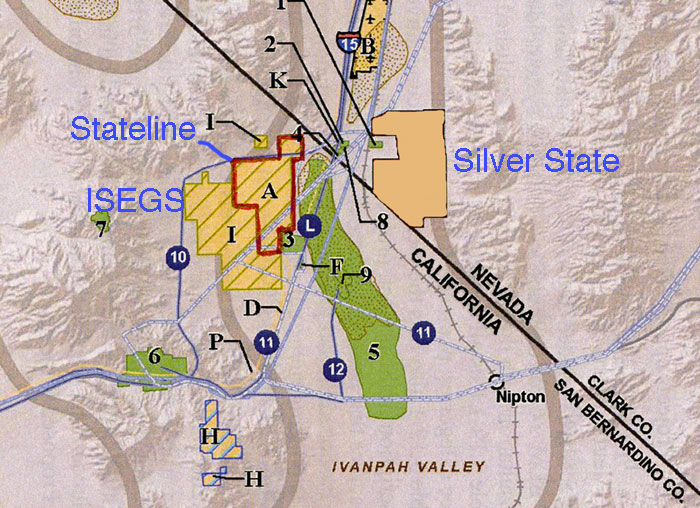2014 Photos of Construction
2014 - Ivanpah Valley CA - Photos of construction on the 300 megawatt photovoltaic project near Primm NV, in the California part of Ivanpah Valley.

^Stateline Solar project under construction in the foreground, with the Ivanpah solar power towers in the background.

Fenceline on the Stateline Solar Farm project under construction, showing the tortoise exclusion fence in 2014.

^Tortoise shade structure along the fence of Stateline Solar Farm, to aid tortoises if they pace the fence trying to get back to their home range, after relocation/translocation.
Compliance Website
December 9, 2015 - This third party website -- http://statelinesolareccmp.com -- monitors compliance reports. The project was sold by First Solar in September to the publicly-traded yieldco vehicle 8point3 (a partnership bteween First Solar and Sunpower). Commercial operation is estimated in September 2016.
Ivanpah Valley: Three Solar Projects
May 22, 2015 - San Bernardino County CA and Clark County NV - Our photos this month showing how largescale solar energy projects fragment Mojave Desert ecosystems: Ivanpah Solar Electric Generating System, Stateline Solar Farm, and Silver State South Solar Farm, >>here.
Grading of Desert Begins
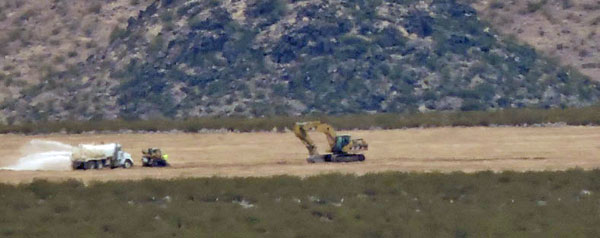
^Tractors and water trucks grade the desert in preparation for placing solar photovoltaic panels. The Metamorphic Hill lies just beyond.
January 22, 2015 - About 1,000 acres have been bulldozed for the Silver State South Solar Farm and another nearly 1,000 acres have been bulldozed for the nearby Stateline Solar Farm as of this week. These projects are being constructed with 100 percent grading of desert ecosystems and tortoise habitat. All in all, now with the Ivanpah solar power towers, about 12 square miles of living desert habitat have been sacrificed for largescale solar projects in Ivanpah Valley, CA and NV.
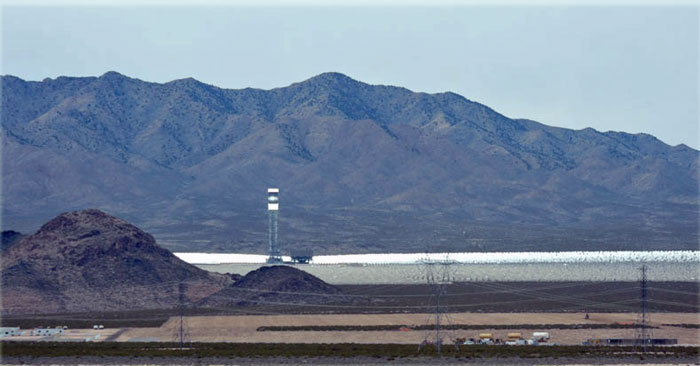
^New grading of the desert for the Stateline project in front of the already completed Ivanpah Solar Electric Generating System in the background. This blocks genetic linkages of tortoise populations in the valley.
Tortoises Overheating at Stateline Solar Project?

November 29, 2014 - San Bernardino County CA - Are tortoises overheating? Although the main construction for the Stateline Solar Project, Ivanpah Valley is just beginning, juvenile and adult desert tortoises have been excavated and removed from the project site. We have not seen a total number, but the reports state that 20 adults have been translocated from the project site. This total does not include juveniles and hatchlings. The problems with translocation are already showing up for the project. Tortoises that have been relocated off of the project site (moved out of the way) are pacing the new fences trying to return to their home range. Some now have suffered from hyperthermia (over-heating) because their homes are off limits now. This includes their known shelters. While the biologists working on the project are doing a good job monitoring the animals, the bottom line is translocation is not good for the desert tortoise. But putting solar panels on rooftops is!
From the compliance reports (all of the tortoises have been assigned numbers): “On desert tortoise fence line inspections on 9/22, SL407, SL415 and SL416 were observed. SL 416 did not show signs of physical distress. SL416, SL415, SL423, SL404 and SL402 were observed on 9/23. On 9/24, SL407, SL402, SL415, SL416, SL435, and SL423 were observed along the fence. SL435 was observed displaying signs of hyperthermia in the early afternoon. Her behavior along the fence was abnormal and she began gapping and foaming at the mouth. SL435 was immediately soaked, provided with water via nasal/oral, and placed in deep shade.”
Solar Scorecard Released by Silicon Valley Toxics Coalition
Novemebr 23, 2014 - On November 11 the Silicon Valley Toxics Coalition (SVTC) today released its fifth annual Solar Scorecard, ranking the world’s largest solar companies on their efforts to improve their environmental impacts.
From their website: for over three decades, SVTC has been a leader in encouraging electronics manufacturers to take lifecycle responsibility for their products. This includes protecting workers from toxic exposure and preventing hazardous e-waste dumping in developing countries like India, Ghana, and China that lack the proper infrastructure to protect workers and the environment. SVTC also seeks to stop the practice of sending e-waste to U.S. prisons for dismantling, which results in toxic exposure to inmates.
The Scorecard is a resource for consumers, institutional purchasers, investors, installers, and anyone who wants to purchase photovoltaic (PV) modules from responsible product stewards. The Scorecard reveals how companies perform on SVTC’s sustainability and social justice benchmarks to ensure that the PV manufacturers protect workers, communities, and the environment. The PV industry’s continued growth makes it critical that action be taken now to reduce the use of toxic chemicals, develop responsible recycling systems, and protect workers throughout global PV supply chains. Many PV companies want to produce truly clean and green energy systems and are taking steps to implement more sustainable practices. We note First Solar gets a zero for biodiversity suatainability.
Tortoises Translocation to Begin
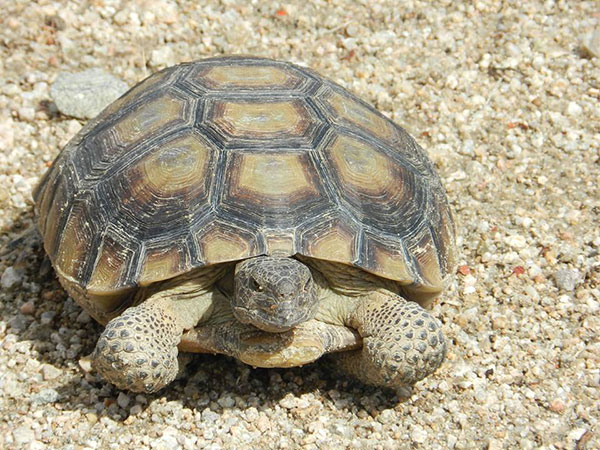
April 4, 2014 - This Friday, First Solar will start digging threatened desert tortoises out of their burrows on about 2,000 more acres of good quality habitat in Ivanpah Valley, California and Nevada. Then the bulldozers will grade the desert ecosystem here to make room for photovoltaic panels that should be going on urban settings. The Interior Department approved two more massive pubic land photovoltaic projects on a critical linkage habitat for the threatened desert tortoise, on public land. The projects are called Silver State South and Stateline.
Defenders of Wildlife Sues to Protect Ivanpah Valley
March 9, 2014 - Defenders of Wildlife went to the courts on March 6 over the approval by Bureau of Land management of the Stateline and Silver State South solar projects that would block tortoise connectivity in Ivanpah Valley, CA. Defendents were named as Sally Jewell, Secretary of the Department of the Interior, Daniel Ashe, Director of the U.S. Fish and Wildlife Service, and Neil Kornze, Director of the Bureau of Land Management.
http://www.defendersblog.org/2014/03/two-many-development-projects-ivanpah-valley/
Stateline and Silver State South Solar Projects Approved
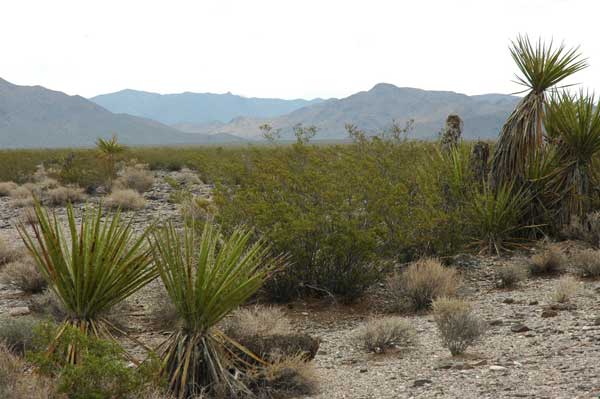
^Mojave yuccas and creosote desert rich with life to be bulldozed and shredded.
February 19, 2014 - Today Secretary of the Interior Sally Jewell announced the approval of two additional solar energy projectsin Ivanpah Valley in California and Nevada, on high quality desert tortoise habitat that will block genetic connectivity between populations in the north and south. US Fish and Wildlife Service had recommended against buolding more largescale solar projects here to maintain tortoise movement corridors, and many environmental groups protested the projects (including Basin & Range Watch).
The 300-megawatt Stateline Solar Farm Project will be built in San Bernardino County, California, on approximately 1,685 acres of public land located two miles south of the California-Nevada border. The second project is the 250-megawatt Silver State South Solar Project located east of Primm, Nevada on approximately 2,400 acres of public land. Both projects are being developed by First Solar and have power purchase agreements from Southern California Edison for 20 years.
Bureau of Land Management Principal Deputy Director Neil Kornze stated, “These solar projects reflect exemplary cooperation between the Bureau of Land Management and other federal, state and local agencies, enabling a thorough environmental review and robust mitigation provisions. Secretary Jewell’s commitment to a landscape-level approach represents a responsible balance between the need for renewable energy and our mandate to protect the public’s natural resources.”
Even though First Solar agreed to reduce the size of the projects, these will still amount to a significant amount of Mojave Desert ecosystems being bulldozed and graded flat, removing 100% of vegetation (not mowed as in the adjacent Ivanpah Solar Generating System design). BLM will expand the nearby Ivanpah Desert Wildlife Management Area by more than 20,000 acres. Basin & Range Watch and the Desert Tortoise Council had advocated for preservation of a much larger area for tortoises, and no more solar projects in this valley.
“As we implement the President’s Climate Action Plan to generate jobs, cut carbon pollution and move our economy toward clean energy sources, we need to do so in a way that takes the long view and avoids or minimizes conflicts with important natural and cultural resources,” said Jewell.
We disagree that this minimizes conflicts with natural and cultural resources (the valley is in the homeland for the Chemehuvi Tribe), but is rather a very poorly sited project in one of the densest tortoise populations left in the desert.
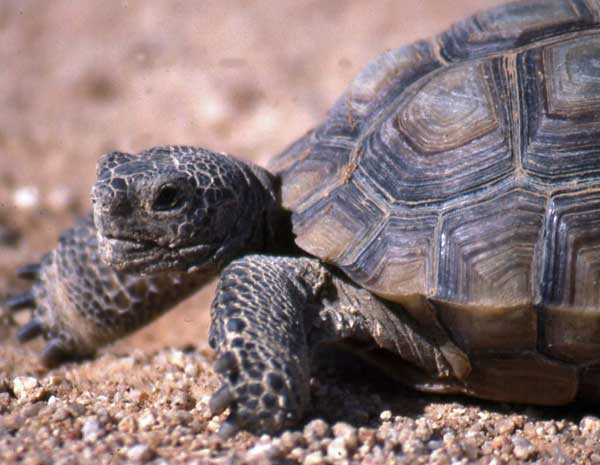
Defenders of Wildlife Sues Over Silver State and Stateline Solar Projects
November 12, 2013 - A big thank you to the Defenders of Wildlife for stepping up and defending the desert tortoise in Ivanpah Valley from big solar energy sprawl. The national environmental organization announced its lawsuit on it's blog today, against Bureau of Land Management, US Fish and Wildlife Service, and the Interior Secretary over the two new solar projects slated for the Ivanpah Valley. Those are the Stateline Solar Farm and the Silver State South Solar Farm totaling about 5,000 acres.
See the Defenders of Wildlife Blog: http://www.defendersblog.org/2013/11/adding-ivanpah/
Biological Opinion for Silver State South and Stateline Solar Projects
October 20, 2013 - On September 30, the US Fish and Wildlife Service completed its Biological Opinion, combined for the Silver State South and Stateline solar projects in Ivanpah Valley, on either side of the California-Nevada border. The Biological Opinion gives guidelines for trying to avoid significant impacts to the Federally Threatened Mojave dese rt tortoise, based on review of Bureau of Land Management right-of-way grants. See Silver State Updates >>here.
Cumulative Impact Huge in Ivanpah Valley
December 3, 2012 - Mojave Desert Blog has provided us with an excellent map of the various large-scale solar projects under review, under construction and completed. The orange polygon shows the agency-preferred alternative 3 of the Stateline solar project. The pink area represents the Silver State South proposal which is currently under review by Bureau of Land Management. The green area is the completed Silver State North solar project. The Ivanpah Solar Electric Generating System project is two-thirds complete in red.
These projects cumulatively have a large impact in northern Ivanpah Valley, cutting off most connectivity for desert tortoises to move from south to north between protected areas. Consider that edge effects mean disturbance from projects will impact the desert outside of project boundaries, thus reducing the amount of undisturbed high-quality habitat in these narrow undeveloped pathways between projects. Wider connectivity corridors are always better to maintain according to conservation biologists.
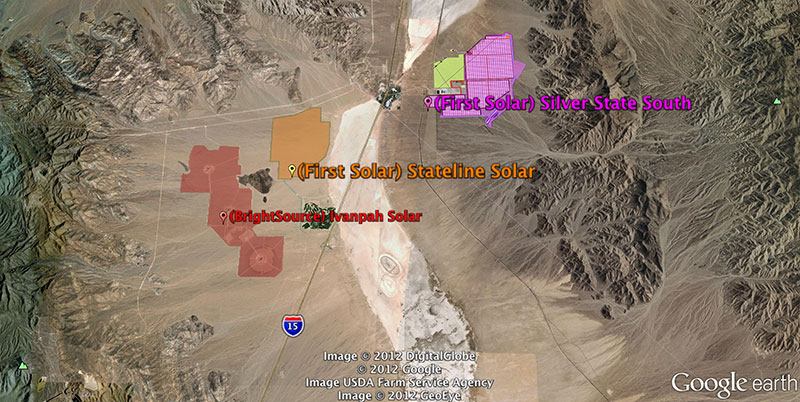
Draft Environmental Impact Statement Released
November 22, 2012 - Desert Stateline LLC (a subsidiary of First Solar Development, Inc.) is pushing ahead with its 300 megawatt thin film photovoltaic project in Ivanpah Valley on the California side. This project will destroy an additional 3.3 square miles of public land and rich Mojave Desert, contrary to US Fish and Wildlife Service recommendations last year that the Bureau of Land Management amend land use plans to prohibit large scale development in the area. As a reminder, that is 2,200 acres of high quality desert tortoise habitat replaced with First Solar's 100 percent clearing for thin-film panels. Basin & Range Watch's Area of Critical Environmental Concern alternative was totally ignored here. The solar facility will connect to the grid via a 2.3 mile 220-kilovolt transmission line.
Public Comments: Publication of the NOA initiates a public comment period of 90 days, ending February 23, 2013. During the comment period, the BLM will solicit public comments on planning issues, concerns, potential impacts, alternatives, and mitigation measures that should be considered in the analysis of the proposed action.
Comments addressed to BLM can be sent by e-mail jchilders@blm.gov, or in writing to the Bureau of Land Management, California Desert District, Attn: Stateline Solar Project, 22835 Calle San Juan de Los Lagos, Moreno Valley, CA 92553.
See the Bureau of Land Management page: http://www.blm.gov/ca/st/en/fo/needles/stateline_solar_farm.html
BLM Reconsiders Public Comment Policy
September 13, 2011 - The U.S. Bureau of Land Management has decided to allow members of the public to speak during meetings held to gather public comments, after the controversy and outcry from the August 31 Stateline Solar Farm scoping meeting in Primm, Nevada (see story below).
http://www.pe.com/localnews/stories/PE_News_Local_D_gag14.3be9676.html
First Solar, in response, also decided to have a separate meeting of their own to listen to public comments concerning the project. They sent an email to interested parties saying BLM and the County would be available to answer questions about the project and the permitting process.
The community meeting will be held on September 19th, from 6 p.m. to 8 p.m. at the Barstow Hampton Inn & Suites, 2710 Lenwood Road, Barstow. The meeting format will include an overview of the project, open comments from attendees, and a moderated question and answer session.
See First Solar's website about the project: http://www.statelinesolar.com/
Public Scoping Meeting Was Not For the Public
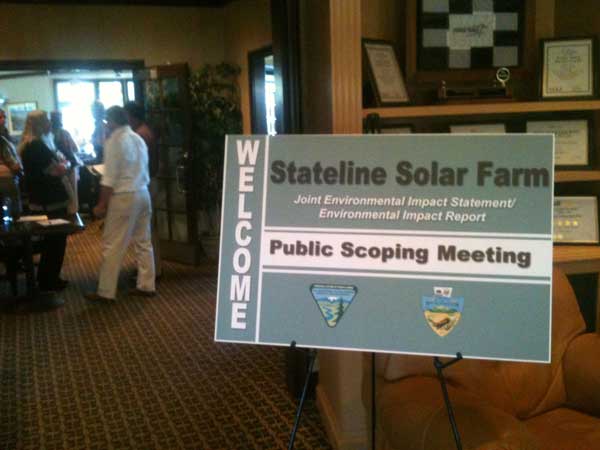
September 3, 2011 - The Moreno Valley office of Bureau of Land Management (not the local Needles BLM office) held what was thought to be a scoping meeting at the Primm golf course for First Solar's Stateline Solar Farm application for a Right-of-Way for about 2,200 acres of public land next to the Ivanpah Solar Electric Generating System. Members of the public drove hours from as far as Palm Springs, Needles, and Las Vegas and beyond to the meeting thinking that they would be able to give voice to comments concerning the project. Union members, environmentalists, members of the Chemehuevi Tribe, and other concerned citizens attended the meeting hoping to have a chance to give comments in a public venue to the federal agency responsible for permitting the project.
They were denied this chance.
The meeting turned out to be a chance for First Solar to tell the public a few items about the proposed project, and then a "crowd-management" session of tables with various contractors available to answer questions privately. This is not what the public wanted. Quite often, in well-run BLM offices, scoping meetings will give people a chance to vocally enter comments into the record, and even have a recorder present to do this. Often an audience wants to hear other's concerns and learn about different issues and opinions. This is democracy after all.
But lately a new style of scoping has emerged, where the public is handed a sheet of paper and in 75 words or less asked to write comments to be handed in to BLM. No oral comments allowed. Jeffery Childers, BLM Project Manager for the application out of Moreno Valley, California, denied the public any chance to give public comments at this meeting after First Solar gave a brief review of the project. In addition, a county sheriff squad car was parked outside the building, and three BLM Law Enforcement Rangers armed with handguns and tasers were present in the room.
The meeting was peaceful, but the audience grew angry at the denial of the ability to voice concerns to the group. Several people attempted to ask public questions anyway, and others piped up to say this entire meeting was a waste of time. Childers would not relent, and the meeting ended rather abruptly. This new form of public management does little to settle public concerns over how public lands are used and public funds expended.
We are in the process of requesting the BLM State Director for additional public meetings so that the public may be given more opportunity to add information about the resources to be impacted.
Stateline Solar Farm: the Latest Project Description
First Solar was formed in 1999 and is a large international solar panel manufacturer (specializing in Cadmium-Telluride thin-film) and project developer based in Arizona. First Solar has a Power Purchase agreement for Stateline with Southern California Edison. The Right-of-Way would be about 2,200 acres, with different options for placing the actual project footprint. The density of tortoises next to the Stateline Hills to the north led biologists to recommend moving the project to the south as one option. One option would be to bifurcate the project north and south of the old Coloseum Mine Road next to the Primm golf course (currently the main entrance road to ISEGS).
A new substation would be built on-site, as well as a new 220 kilovolt transmission line to tie in the the Eldorado-Ivanpah transmission line currently being upgraded for renewable energy in the valley. First Solar hopes to begin construction in mid-2013 and finish at the end of 2016. Construction jobs were said to number 400, but only 12 permanent jobs would be provided. First Solar said it would provide $70 million to the state in sales taxes and county property taxes. 165,000 metric tons of CO2 would be avoided (however, this does not take into account the unknown amount of CO2 sequestered in desert soils and vegetation). Solar panels would be 8 feet high, but the project would need to grade the desert 100%.
First Solar announced that it will provide the world's first pre-funded module take-back and recycling program for the solar panels. New modules would apparently be produced from decommissioned ones at the end of the project's lifetime (usually 30 years). This would be better for the environment since Cadmium is a known carcinogen.
One person sitting in the audience slipped in a public question before the shut down: how much water will the project need to wash the panels? A First Solar representative answered that no water would be needed for panel washing during operations. Dust would not be a concern apparently. But after the public part of the meeting, we asked First Solar's contractor AECOM, who was available for questioning; the contractor said the panels would need washing in the dusty desert, and 2 to 3 acre-feet per year (afy) was budgeted out from wells that would be drilled in the ROW. If not washed, there would be a loss of energy, this contractor told us. Construction water needs would be 1,600 afy over three years.
First Solar said it was not applying for a Department of Energy Loan Guarantee for this project.
Finally, a County of San Bernardino representative explained to us that they would be the lead agency to do environmental review under the California Environmental Quality Act, and give a discretionary permit to First Solar for water use. New wells would be drilled. The public has until September 23 to submit comments.

^Public meeting in Primm.
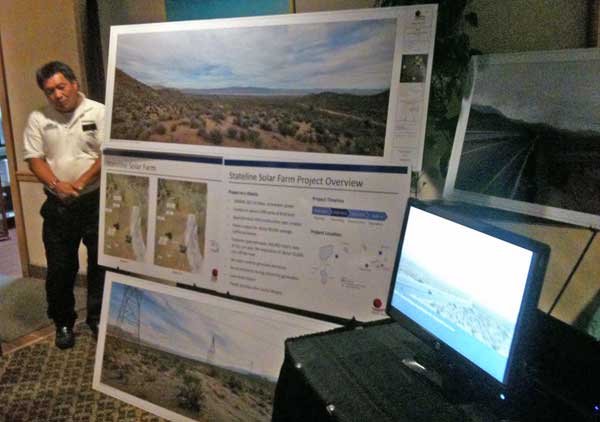
^First Solar project maps and digital imaging of what the project would look like.
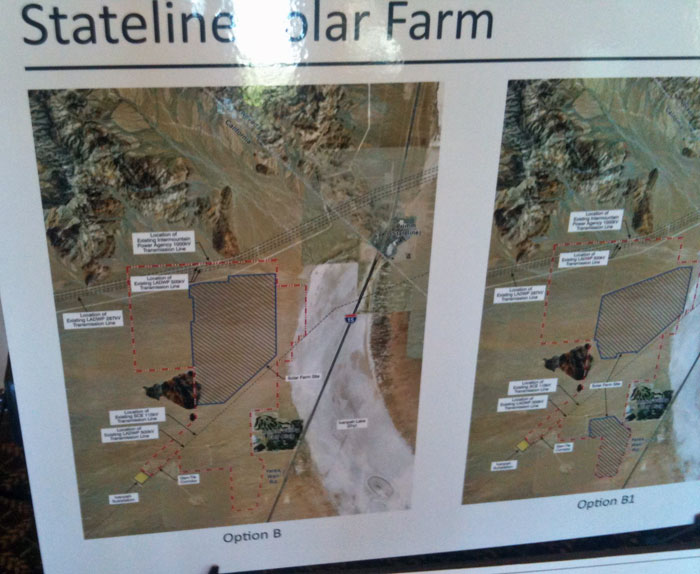
^First Solar has two current options for the lay-out of the footprint of their photovoltaic power plant within the Right-of-Way.

^The bifurcated option for the project layout. Primm Valley Golf Course is to the right. From the Plan of Development.

^First Solar digital image of how the photovoltaic project would appear from the foothills of Clark Mountain. Looking northeast towards Primm and the McCullough Mountains Wilderness.
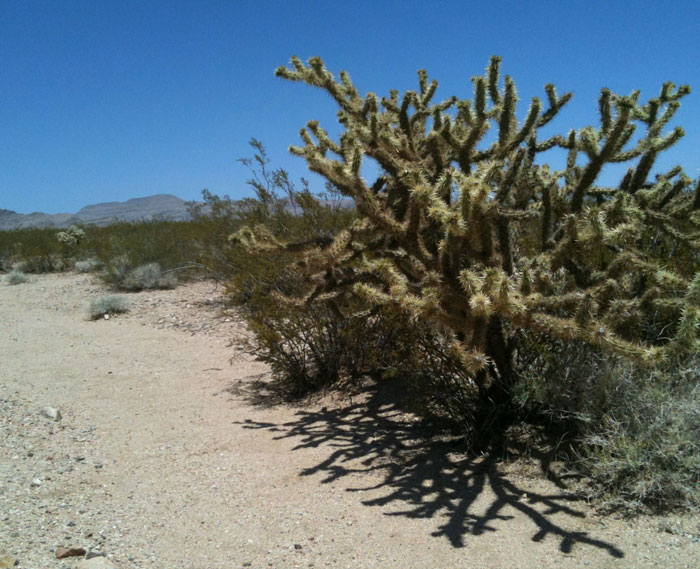
^Buckhorn cholla (Cylindropuntia acanthocarpa) on the project site.
Project datasheets handed out at the scoping meeting:
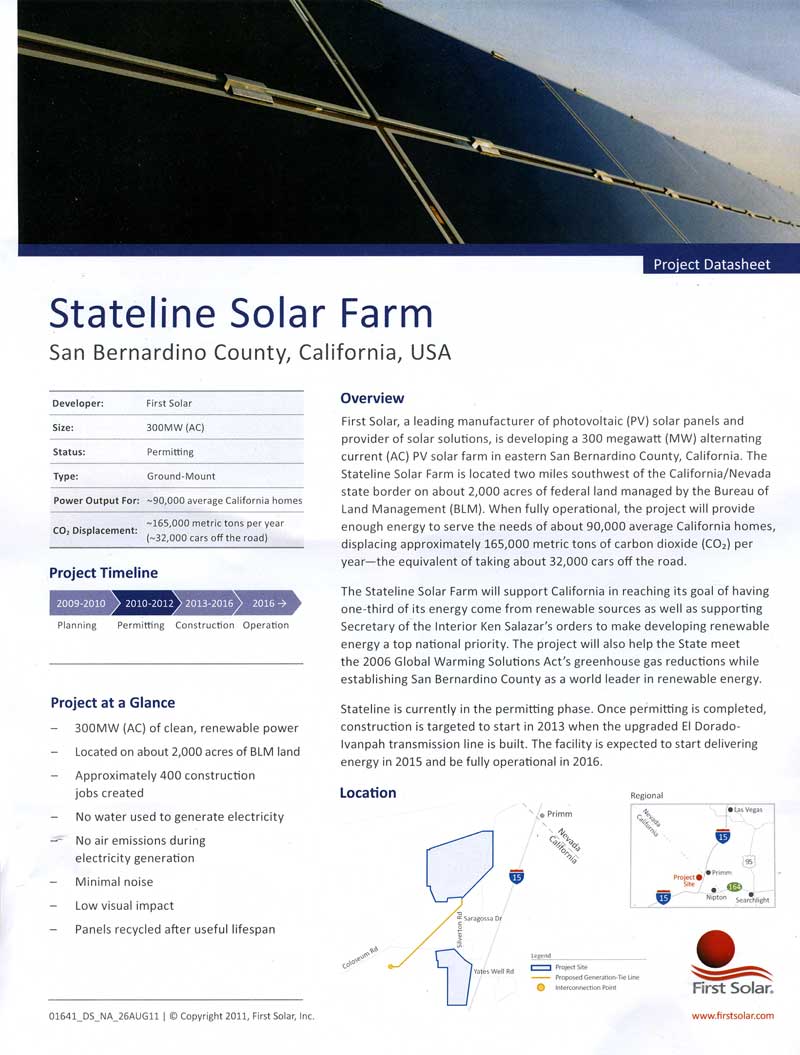
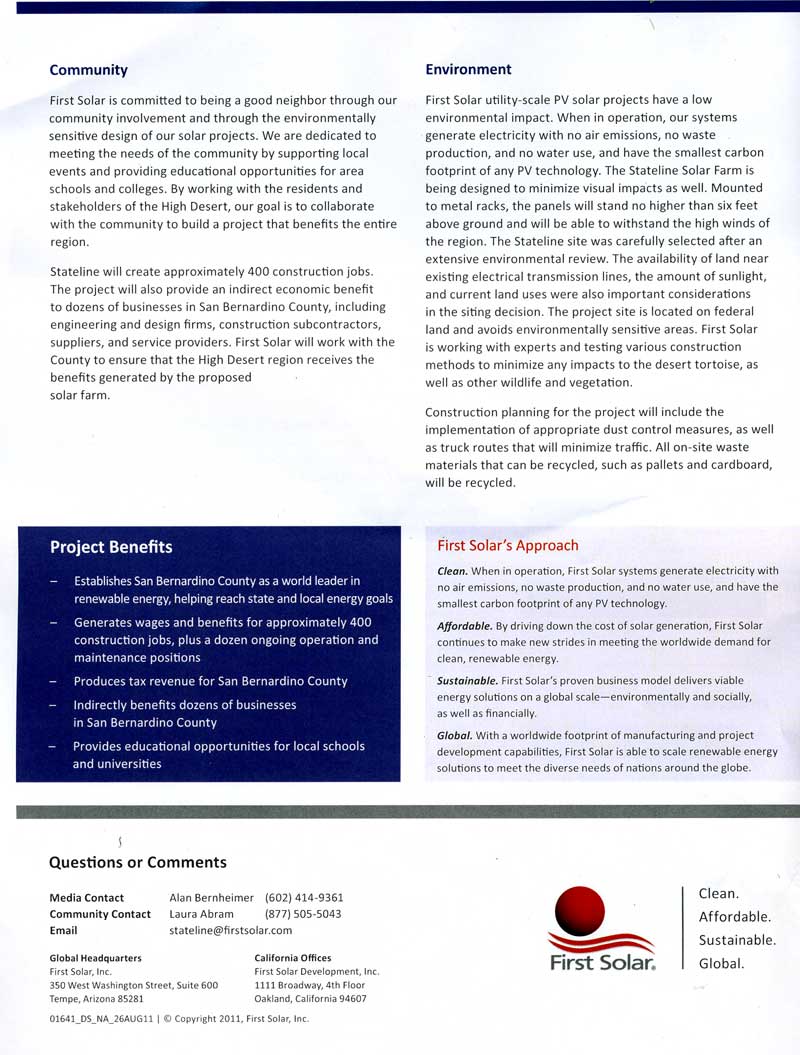
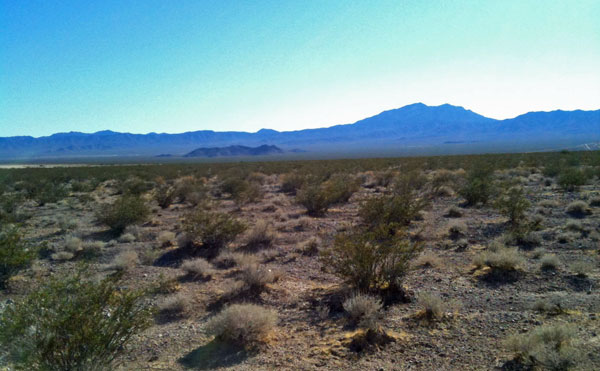
^Clark Mountain looms over Ivanpah Valley. The Stateline Solar Farm project would lie next to the dark Metamorphic Hill in the valley floor distance.
^Map showing the First Solar Stateline photovoltaic project next to the Ivanpah Solar Electric Generating System (ISEGS) project now under construction, and First Solar PV project in Nevada. H is a proposed Iberdrola wind project. Green areas are: 3 - Primm Valley Golf Course, 5 - Ivanpah Dry Lake Special Recreation Management Area (for wind-sailing), 6 - Molycorps Mine, 7 - Coloseum Mine. 11 is the proposed Ivanpah-Eldorado Transmission line upgrade. B is the proposed Southern Nevada Supplemental Airport.
Environmental Review Begins
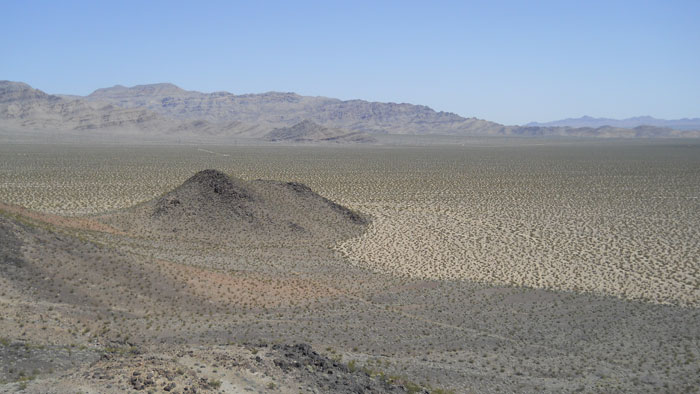
^View of the Stateline Solar Farm proposed project site on the valley fans, from the Metamorphic Hill. The Stateline Wilderness Area lies on the range beyond.
August 4, 2011 - A Notice of Intent to begin preparation of an Environmental Impact Statement appeared today in the Federal Register. The 2,000 acres thin-film photovoltaic project of 300 megawatts would be within a few miles of Unit 3 of the Ivanpah Solar Electric Generating System. Cumulative impacts on desert tortoise could be devastating.
Comments on issues related to the EIS may be submitted in writing until September 6, 2011. Send comments to:
Web site: http://www.blm.gov/ca/st/en/fo/cdd.html.
E-mail: statelinesolar@blm.gov.
Fax: (951) 697-5299.
Mail: ATTN: Jeffery Childers, Project Manager, BLM California Desert District Office, 22835 Calle San Juan de Los Lagos, Moreno Valley, California 92553-9046.
First Solar has requested a ROW authorization to construct, operate, maintain, and decommission the 300-MW PV Stateline solar energy project. The BLM is responding to First Solar's ROW application as required by FLPMA. The Stateline project would be located on BLM-administered lands and would include access roads, PV arrays, an electrical substation, meteorological station, monitoring and maintenance facility, and a 2.3 mile generation tie-line on approximately 2,000 acres. Potential alternatives to the proposed action may include reduced acreage, reduced MW, and/or modified footprint alternatives. The project location is in San Bernardino County approximately 2 miles south of the Nevada-California border and 0.5 miles west of Interstate 15. The purpose of the public scoping process is to determine relevant issues that will influence the scope of the environmental analysis, including alternatives, and guide the process for developing the EIS. At present, the BLM has identified the following preliminary issues: special status species, cultural resources, route designation, social and economic impacts, traffic, water, and visual resource resources.
Pursuant to the BLM's CDCA Plan, sites associated with power generation or transmission not identified in the CDCA Plan will be considered through the plan amendment process to determine the suitability of the site for solar development. The BLM may also consider additional potential plan amendments to the CDCA Plan and the Las Vegas RMP that might arise based on its assessment of the potential cumulative effects of other projects in the larger Ivanpah Valley watershed in California and Nevada to a range of resources, including, without limitation, biological, physical, and cultural resources. By this notice, the BLM is complying with requirements in 43 CFR 1610.2(c) to notify the public of potential amendments to the CDCA Plan and Las Vegas RMP, predicated on the findings of the EIS. If land use plan amendments are necessary, the BLM will integrate the land use planning process with the NEPA process for the Stateline project.
The plan amendments will be completed in compliance with FLPMA, NEPA, and all other relevant Federal law, executive orders, and BLM policies. Any new plan decisions will complement existing plan decisions and recognize valid existing rights.Show citation box
The BLM will use and coordinate the NEPA commenting process to satisfy the public involvement process pursuant to Section 106 of the National Historic Preservation Act (NHPA) (16 U.S.C. 470f) as provided for in 36 CFR 800.2(d)(3). Native American tribal consultations will be conducted in accordance with policy, and tribal concerns will be given due consideration, including impacts on Indian trust assets. Federal, State, and local agencies, along with other stakeholders that may be interested or affected by the BLM's decision on this project, are invited to participate in the scoping process and, if eligible, may request or be requested by the BLM to participate as a cooperating agency. In connection with its processing of First Solar's ROW application, the BLM is also segregating, under the authority contained in 43 CFR 2091.3-1(e) and 43 CFR 2804.25(e), subject to valid existing rights, the public lands within the Stateline application area from the operation of the public land laws including the Mining Law, but not the Mineral Leasing or the Material Sales Acts, for a period of 2 years from the date of publication of this notice. The public lands contained within this segregation total approximately 2,000 acres.
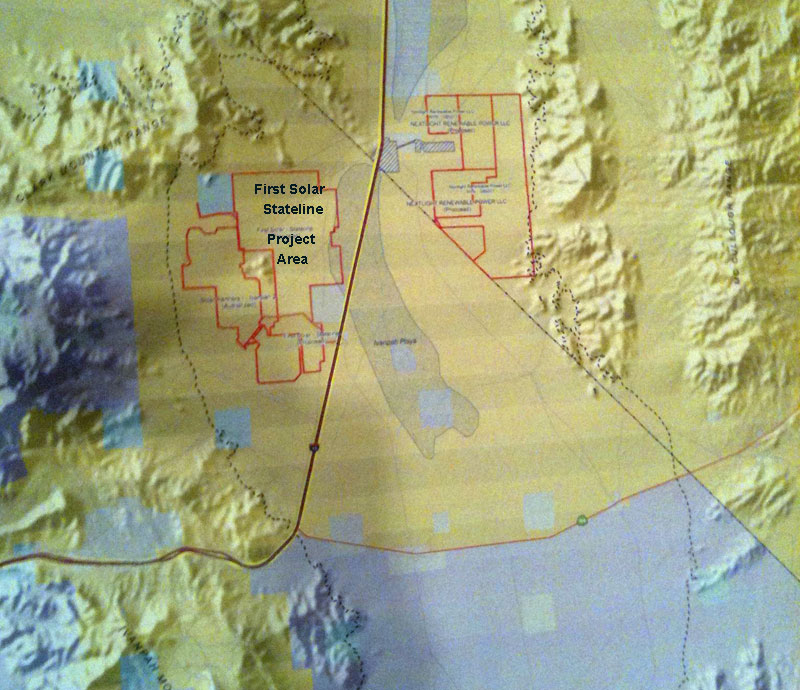
^The 2,000 acre Right-of-Way would lie somewhere in this larger Project Area shown on the map above.
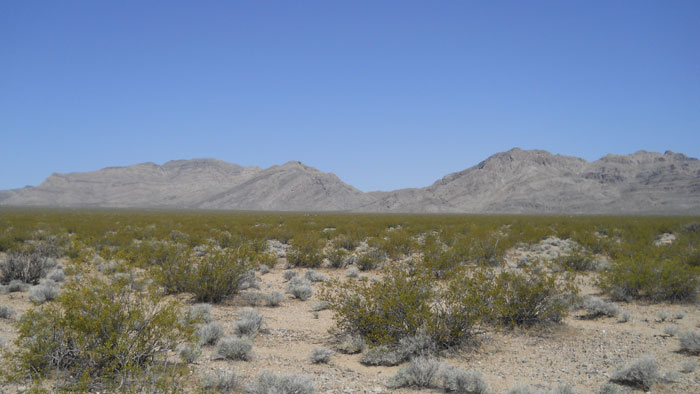
^Stateline solar project site, healthy creosote-bursage Mojave desert. The Stateline Hills lie in the background.
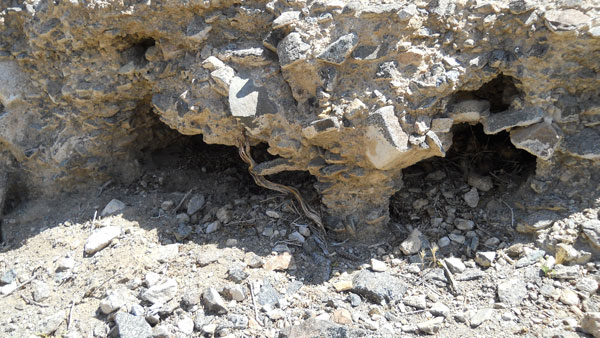
^Desert tortoise burrow in a caliche cave on the project site.
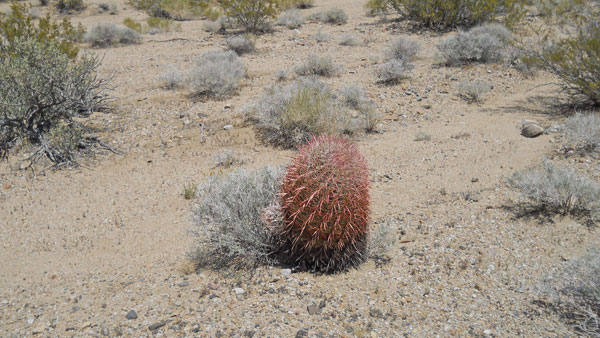
^Barrel cactus (Ferocactus cylindraceus) on the project site.

^Carbon-storing biological soil crusts made of algae, fungi, and mosses, on the project site.
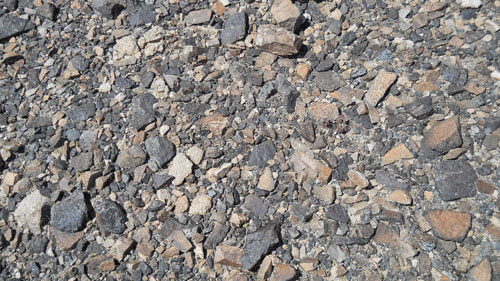
^Desert pavement, a natural soil type, on the site.
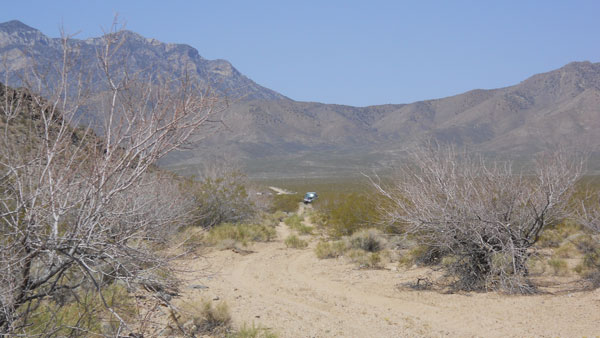
^Driving on small dirt roads, biologists survey for areas to translocate tortoises from the Ivanpah Solar Electric Generating System site nearby. Only so many tortoises can be moved into any one area, where will more desert habitat be found?
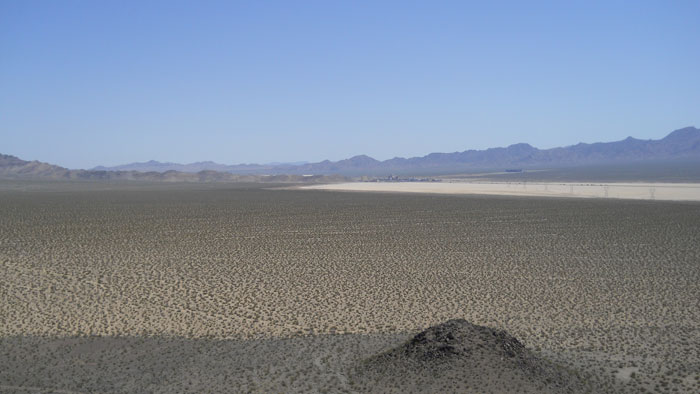
^Stateline Solar Farm project area on the flat west of Ivanpah Dry Lake and Primm in the distance. Looking north.
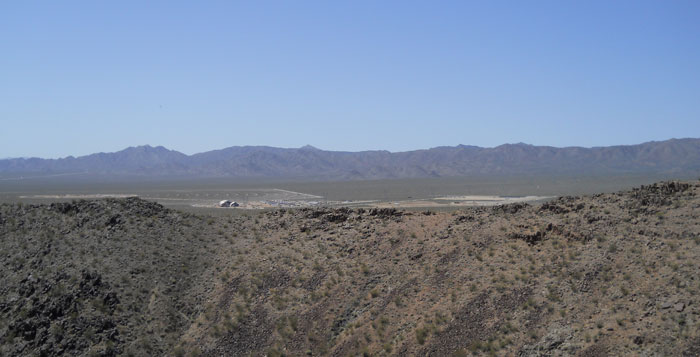
^Looking south, ISEGS is under construction. View from the Metamorphic Hill lying between the two projects.
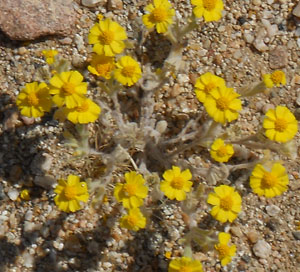
^Woolly aster (Eriophyllum wallacei) on the project site.
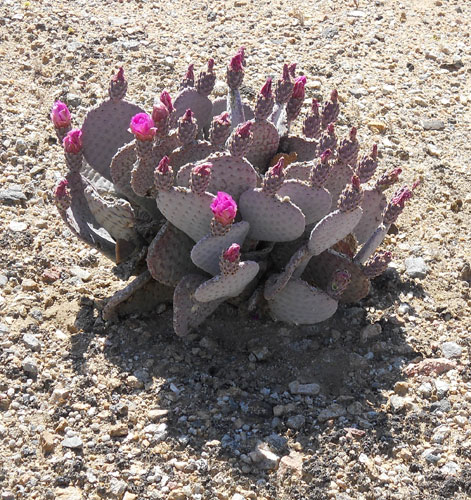
^Beavertail (Opuntia basilaris).
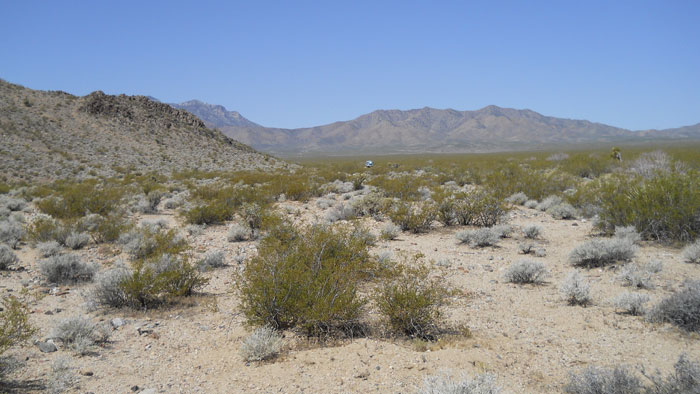
^Biologists survey for tortoises on the northeast side of the Metamorphic Hill, near the Stateline project.
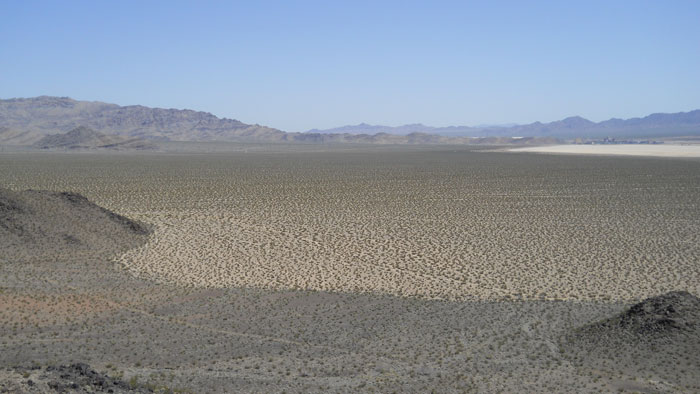
^This fan would have to be graded 100% to place a photovoltaic power plant on it.
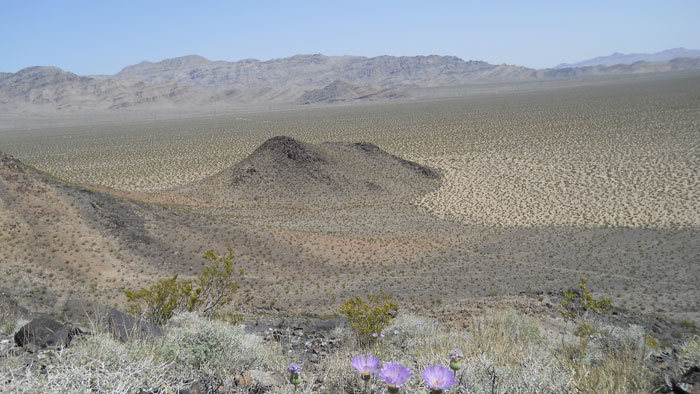
^Mojave aster (Xylorhiza tortifolia) blooming on the Metamorphic Hill, overlooking the proposed First Solar project.
First Solar Claims Only 12 Tortoises on Their Ivanpah Valley California Project
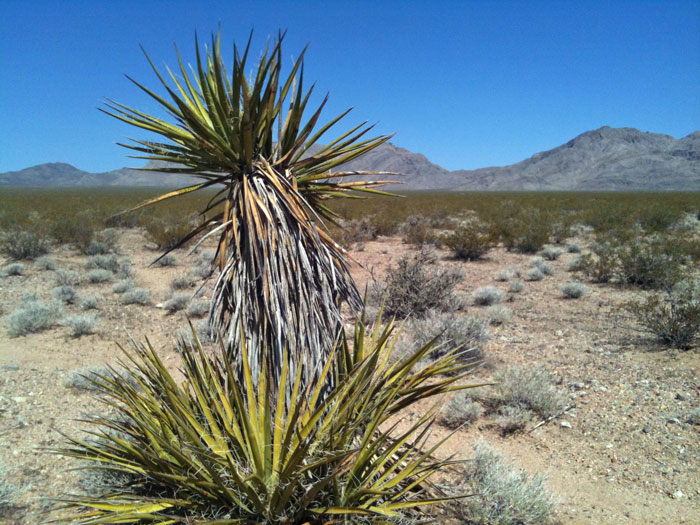
^Mojave yucca on the Stateline Solar Farm project site in Ivanpah Valley, excellent tortoise habitat.
May 28, 2011 - It would appear that the Bureau of Land Management is going to entertain the idea of approving a 2,154 acre solar development right next to the Ivanpah Solar Electric Generating System site which has been making so much news due to the high desert tortoise numbers. First Solar is claiming that they will only need to avoid 12 desert tortoises for their proposed Stateline Project. They conducted a couple of surveys this spring. These were "presence/absence" surveys and First Solar is concluding that they can "avoid" the tortoises they found, as if these tortoises don't ever move. Tortoises can have a home range of up to two square miles. This also happens to be a fairly dry year in Ivanpah Valley. A presence/absence survey only counts the desert tortoises that are seen on the survey. As you may remember, BrightSource only used presence/absence surveys from a dry year to conclude that only 25 desert tortoises would be on the Ivanpah site. They were off by over 100. Now First Solar is concluding that only 12 will need to be avoided on a site that is right next to the biologically rich Ivanpah site? Consider that a desert tortoise spends over 80 percent of its life under the ground. Consider that on a dry year, some tortoises will not emerge from their burrows very often. Consider that most biologists feel that a "mark/recapture" survey over a period of years is the best way to count a desert tortoise population.
To attempt to "avoid" tortoises, First Solar wants to move 20 megawatts of power in the project from the northern section to the east and 88 megawatts will be moved to the south, said Director of Project Development Mike Argentine. This would supposedly avoid 3 tortoises by shifting the panels, said Argentine. The company is continuing surveys for the tortoises and is looking for areas without desert tortoises.
A notice of intent for the project should be published in the federal register by the end of the month, said Argentine. Public scoping meetings on the project should be held before the end of June and a draft environmental impact statement should be out by the end of 2011, said Argentine. Construction of the project will take about two to three years and provide about 400 construction jobs.
See http://www.desertdispatch.com/news/transmission-10947-california-around.html
First Solar, according to short-seller Jim Chanos of Kynikos Associates, has questionable technology issues, and the company is guiding negative free cash flow in 2011. Its technology is second rate, which is causing the business to deteriorate. It suffers from operational issues, balance sheet deterioration, and has been not as successful as it wanted in growing revenue outside of Europe.
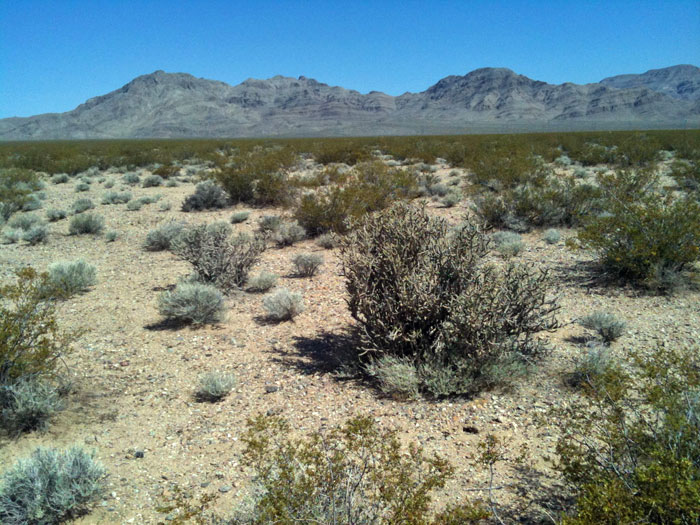
^Pencil cholla on Stateline project site. Old growth Mojave Desert.
Ivanpah Valley Sees More Big Solar
December 1, 2010 - Primm, Nevada - First Solar Development, Inc. is proposing a 300 megawatt Cadmium-Telluride thin-film photovoltaic project in eastern San Bernardino County next to the Nevada state line. This project lies along the eastern boundary of the approved Ivanpah Solar Electric Generating System power tower project, adding to the already considerable cumulative impacts to the Federally Threatened Desert tortoise (Gopherus agassizii) and Mojave Desert scrub. The project would also need a new 220 kV gen-tie transmission line within the existing transmission corridor, and a new substation. The Project Study Area on Bureau of Land Management land would be 5,454 acres, and a Preferred Project area would require approximately 2,153 acres. See the Plan of Development.
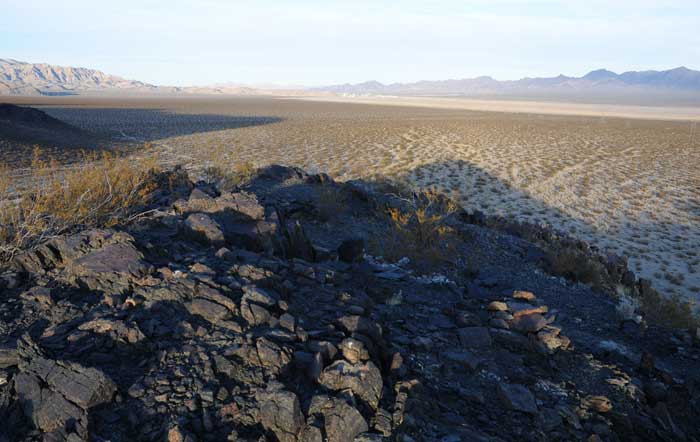
^The project site lies on this flat east of the Metamorphic Hill. The large Ivanpah Solar Electric Generating System project takes up the valley floor to the west of this hill.
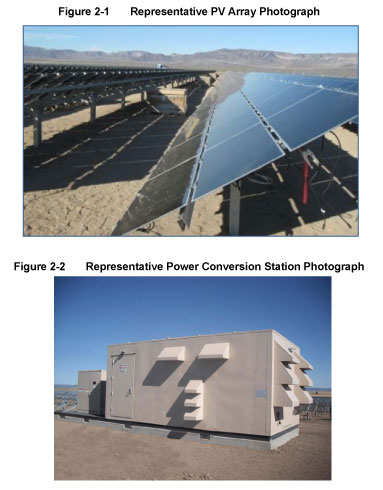
The BLM-designated Stateline Wilderness Area is located less than one mile northwest of the Project Study Area.
PV modules will be mounted in tables that will connect, via angled brackets, to steel columns which will be driven into the ground.
During the approximately 15-month construction period, an estimated total of 1,900 acre-feet of water will be needed for such uses as soil compaction, dust control, and sanitary needs. Water for the construction and operation of the Project would be drawn from a combination of up to four different wells on or near the Project site operated by the Primadonna Co., LLC and the PRMA Land Development Company or from newly established wells. The wells are located within the Ivanpah Ground Water Basin. During operations, one permanent, approximately 5,000-gallon, above-ground water storage tank will be installed adjacent to the M&M facility. Because of the Project’s small operating workforce (7 full time equivalent workers), water demand will be no more than a few hundred gallons per day.
Debris basins are planned to control floods through the site.
The Project would interconnect with the proposed 220 kV El Dorado-Ivanpah transmission system, which would replace the existing 115 kV transmission line, via the future SCE Ivanpah Substation, which would be located 2.3 miles southwest of the Solar Farm Site. SCE estimates that the El Dorado-Ivanpah transmission system project, including the Ivanpah Substation, will be completed by July 2013.
As the Project approaches the end of its useful life, the component parts would be dismantled and recycled. First Solar has a pre-funded recycling program for all of its solar modules as described in the following paragraphs.
First Solar’s current market capitalization is approximately $10.8 billion (as of August 26, 2010), the largest in the solar power industry. Due to its sound credit profile and financial flexibility, First Solar is currently funding all active projects in the development phase on balance sheets which have totaled over $50 million in 2009 and are forecasted to total in excess of $100 million in 2010. First Solar believes its own balance sheet is the most flexible source of available development capital for its funding requirements. For construction and term period financing needs of the Project, First Solar intends to solicit debt and equity partners. Over the last year, First Solar has run three successful auctions in the project equity market (focused on strategic equity, private equity, insurance companies, and infrastructure funds), all three of which resulted in secured commitments. In addition, First Solar has started to develop key relationships in the project debt market (bonds, banks, and insurance companies). First Solar’s access to the project debt market is also enhanced by its proven access to the capital market, as it secured a corporate credit facility earlier this year with a syndicate comprised of the leading investment banking institutions.
Cumulative Impacts to Tortoise
The Plan of Development states that 27 live tortoises and 35 active burrows/pallets were recorded within the Project Study Area during 2008 and 2009 surveys. In addition, 295 inactive burrows/pallets ranging in quality from poor to good were recorded within the Project Study Area. Based on US Fish and Wildlife Service formula for estimating the total number of tortoise, 67 tortoises are estimated to occur within the Project Study Area. Based on the total area surveyed, the Project Study Area supports an estimated average density of 6.9 tortoises per square mile.
Observations of active tortoise sign were not evenly distributed throughout the Project Study Area. Sign of recent tortoise activity was concentrated in three distinct locations: (1) northeast quadrant of Section 22 and southeast quadrant of Section 15, (2) southeastern quadrant of Section 22, and (3) north-central quadrant of Section 23. Other sporadic sign of tortoise activity outside the main concentration areas occurred in Sections 14 and 26. No tortoises or active burrows were found within 1,700 meters of the western edge of the lakebed. Further, no tortoises were observed within Section 12, located in the northern limits of the Project Study Area. Over 100 carcasses were detected during the surveys; most of which (74%) were estimated to have been greater than 4 years since death.
The Solar Farm Site for the Preferred Alternative (Alternative B) supported tortoise concentrations in Sections 14 and 23. Twelve tortoises were found within the Preferred Solar Farm Site. Based on the formula in the USFWS 2010 protocol, an estimated 30 tortoises may occur within the Preferred Solar Farm Site. Using the total area, the estimated density within the Preferred Solar Farm site is 9 tortoises per square mile. Eighty potential tortoise burrows were recorded within the Preferred Solar Farm Site, of which only nine indicated sign of recent use at the time of surveys. Thirty-three carcasses were recorded within the Preferred Solar Farm Site, of which 50% had a time-since-death (TSD) estimate of greater than four years and four carcasses appears to have a TSD estimate of one to two years. Thirty locations of tortoise scat were recorded within the Preferred Solar Farm Site, with approximately 60% appeared to be deposited during the year of survey.
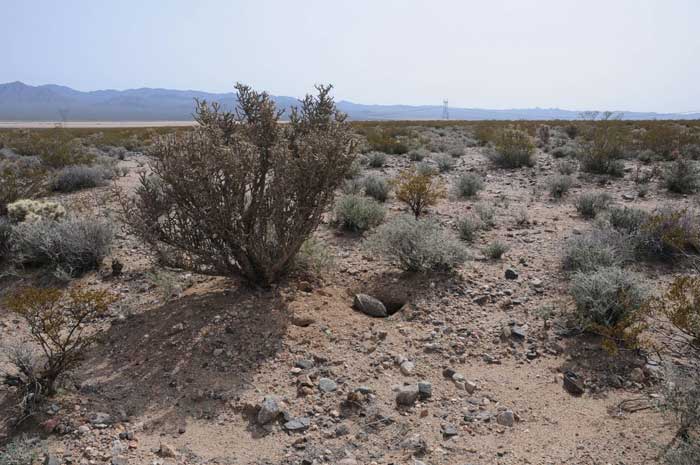
^This Desert tortoise is on the proposed Stateline Solar Farm project site, a pristine Mojave Desert Scrub with beautiful tall Pencil cholla (Cylindropuntia ramosissima).
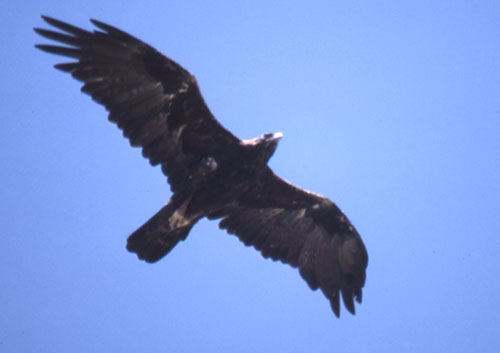
^Golden eagle (Aquila chrysaetos).
Golden eagle: Two phases of aerial surveys to assess golden eagle occupancy and productivity were conducted within a ten-mile buffer of the Preferred Solar Farm Site in 2010 by the Wildlife Research Institute (WRI). Direct observations of golden eagles were recorded in vicinities of the Clark Mountains and the Umberci Mine. Fifty-five nests were observed within twelve territories, seven of which were active. A five-mile buffer was applied to each active nest to model the estimated territory size and potential foraging area. One territory belonging to an eagle located near the Umberci Mine encompasses the Preferred Solar Farm Site. It should be noted that the five-mile buffer may not be accurate and that actual territories vary in size, some much greater than five miles, due to topography and other factors. Many of the observed nests were likely alternative nest sites for the same territory. None of the territories were found to be engaged or successful in producing young for the 2010 breeding season. The lack of successful breeding may be attributed to natural annual variation due to high energy and time demands. Also, continued drought conditions may have an adverse effect on golden eagle reproduction efforts. Additionally, it is possible that some golden eagles may have attempted to reproduce early in the season and subsequently failed prior to the survey effort.
Wildlife: Other species observed during the golden eagle surveys included American kestrel (Falco sparverius), Nelson’s bighorn sheep (Ovis canadensis nelsoni), bobcat (Lynx rufus), common raven (Corvus corax), great horned owl (Bubo virginianus), mule deer (Odocoileus hemionus), peregrine falcon (Falco peregrinus), prairie falcon (Falco mexicanus), red-tailed hawk (Buteo jamaicensis), and wild burro (Equus africanus asinus). Other special status wildlife species observed during the tortoise and golden eagle surveys included loggerhead shrike (Lanius ludovicianus), burrowing owl (Athene cunicularia) and LeConte’s thrasher (Toxostoma lecontei).
Bat Species: Nine bat species potentially occur within the Project Study Area. Three of these species are State Species of Special Concern including pallid bat (Antrozous pallidus), western mastiff bat (Eumops perotis californicus), and Townsend’s big-eared bat (Plecotus townsendii). Mexican free-tailed bat (Tadarida brasiliensis), big brown bat (southern California population, Eptesicus fuscus pallidus), hoary bat (Lasiurus cinereus), California myotis (Myotis californicus), small-footed myotis (Myotis ciliolabrum), and western pipistrelle (Pipistrellus hesperus) are non-special status species with the potential to occur within the Study Area. The rocky hills immediately adjacent to the Project Study Area (e.g., Stateline Hills, Metamorphic Hills, and Clark Mountains) provide ample crevice roosting habitat for several bat species. A documented roost for the sensitive Townsend’s big-eared bat occurs at the Umberci Mine in the Clark Mountain Range about three miles northwest of the Project Study Area. Guano of pallid bats was found in a shallow rock cave in the foothills of the Stateline Hills. The guano was probably deposited by bats night roosting between foraging bouts. A mine shaft was located below the cave. Pallid bats and western pipistrelles have a potential to roost within small rock crevices on the ground within the northern and westernmost sections of the Project Study Area. Other bat species may be present while foraging but are not expected to roost within the Project Study Area.
Special Status Plant Species: Within the Preferred Solar Farm Site, five special status plant species were found:
Mojave milkweed (Asclepias nyctaginifolia, CNPS List 2.1) – 90 individuals at 11 locations;
Small-flowered androstephium (Androstephium breviflorum, CNPS List 2.2) – 67 individuals at 51 locations;
Parish’s club-cholla (Grusonia parishi, CNPS List 2.3) – 19 individuals at 9 locations;
Desert pincushion (Coryphantha chlorantha, CNPS List 2.1) – 8 individuals at 8 locations;
Utah vine milkweed (Cynanchum utahense, CNPS List 4.3) – 5 individuals at 4 locations; and
Rusby's desert mallow (Sphaeralcea rusbyi var. eremicola, CNPS List 1B.2) – 5 individuals at 3 locations.
Two other species were recorded outside the Preferred Solar Farm Site including viviparous foxtail cactus (Coryphantha vivipara var. rosea, CNPS List 2.2) and nine-awned pappusgrass (Enneapogon desvauxii, CNPS List 2.2). These species were recorded within the northwest quarter of Section 15, northern quadrant of Section 14, and throughout Section 12. More than 190 species of plants were identified during the surveys. No federal- or state-listed (endangered or threatened) species were observed.
Cultural Resources: 11 prehistoric archaeological sites, 1 prehistoric isolated find, 1 multi-component archaeological site, and 3 historic archaeological sites were found in a literature search within the Project Study Area and one-mile buffer.
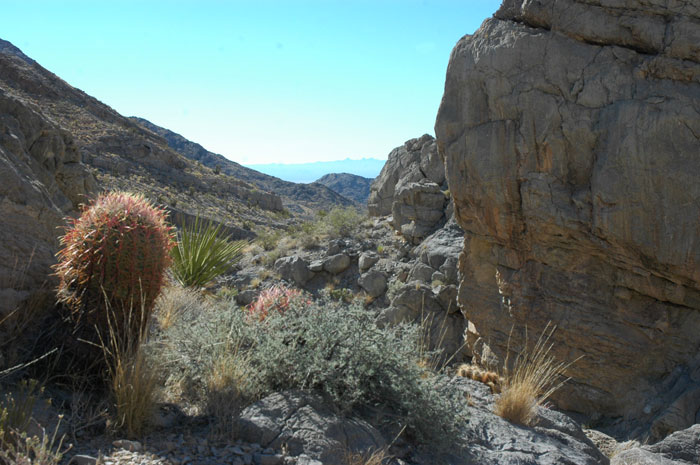
^Limestone canyons of Stateline Wilderness, a mile away from the industrial PV project proposal.
HOME.....Ivanpah Solar Electric Generating System.....First Solar Silver State Project
